by Paul Dufresne
Quite simply, when Endotapping is combined with Bomb-proofing, it is absolutely the most powerful way of allowing a horse and its leader to obtain success in overcoming the challenges of dealing with the ever-changing human oriented environment. I have used all kinds of basic Natural Horsemanship techniques of advance/retreat and even my more progressive Leadership By Example and proving to the horse there is nothing to fear, but nothing has yet compared to the Endotapping in the face of a scary situation. As it was described in the last two installments it is a neuromuscular hormonal stimulation which causes the release of endorphins in the body causing a stay and play response rather then the opposite of adrenalin in the fear/excite responses in a prey animal causing flight.
Bomb-proofing should only be tackled after you have already developed reasonable relaxation cues with a horse. To do so without relaxation cues is simply setting up a horse to fail and mistrust your lead. The best way to explain this is to show you with an example. I will pick the tarp as a prop as it is quite challenging with most horses because of its property of picking up life, noise, snagging a foot…..and we can also go from simple steps to canter. First I have the horse follow from behind me on a fairly loose lead, without looking at the horse and just focusing on the tarp I would go up to it and beat the crap out of it!!! Maybe even kneel or sit on it doing so again all of this without looking at the horse, giving it absolutely no reason to be concerned. Leading by example is just good progressive TFC leadership and not really endotapping but without it you are just making it so much harder for your horse to be exceptionally brave.
Once the horse has observed you thrashing this tarp with confidence then you can approach your horse and ask it to advance by driving it. First I ask it to bring its head down and relax, once it has and only once it has I then ask it to try to move forward with a nudge of the whip. Any type of forward lean I would reward if the horse is terribly concerned by releasing forward pressure and then tapping it till it yields it head down and then offer its poll. I would then ask it to try again to move forward, when the horse attempts I leave it alone momentarily and then start to tap it if it is concerned till again it drops it head down and relaxes its poll. This may go quite slowly for some horses but the coolest thing is that if you wait till the horse tells you it is ready to do more when you ask it, you will not be repeating this for a multitude of times as you might with horses using most other techniques. Sometimes you have to be willing to go real slow so that you can go much faster safely later. Not all horses are the same, some are easier and some have such strong fear/excite cycles that without this you could be struggling for some time. I have yet to see a horse stuck for very long with endotapping (this is in horse time by the way and not the impatient human time….which is far too quick).
Quite simply just keep adding a step at a time. Retreating is not really necessary in most cases as you always bring the horse back to the feel good by tapping and only asking it to go forward once it has told you it is ok. If the horse does retreat, telling you it needs more space, just resist it and when it stops where it can deal with it, then simply repeat the steps again. The coolest thing is that as the lead gets so pre-occupied with keeping in touch with the needs of the horse they don’t realize how many times they have repeated the steps - but now they have also gained better control of the horse’s poll. Gaining better cues to soften the poll makes it so much easier to then do so in performance movements, exercises in-hand or riding.
Otis, the horse in the photos to the right, was a horse I used at a demo night at a clinic at Clearview arena in Qu’Appelle Sask. His owner was near the last straw as he kept exploding, bolting, pulling, running through the lead or rein. He had to learn basic yields and then go on a circle with positive bend developing good relaxation cues facilitated by Endotapping. He then learned with good leadership that he could cope with his fears in positive ways if we were willing to listen to his needs. In the ensuing clinic. Otis was the second best horse at the clinic. Following the clinic no one at the barn recognized him initially because he was so calm. I was thrilled for how owner and look forward to seeing them progressing safely in their positive relationship. This approach works with all forms of challenging situations. Look at the characteristics of any challenge. Looking at all the potential snags and then tackle it one step at a time. If you always regain the FEEL GOOD and you can’t go wrong!
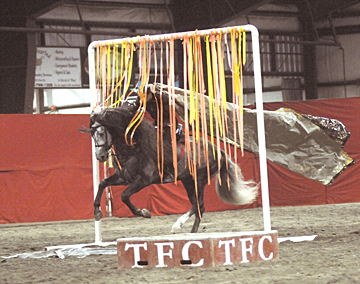
Padrino "running the gauntlet" at a recent exhibition
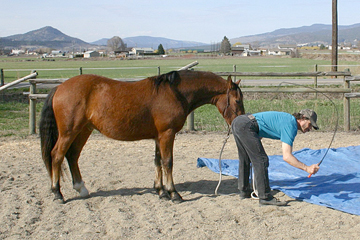
Beating the tarp without focusing on the horse
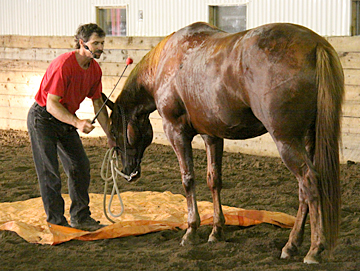
Tapping Otis to relax at the tarp
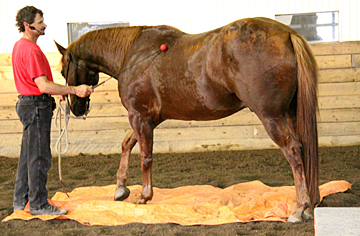
Tapping Otis to help him cross the tarp without fear
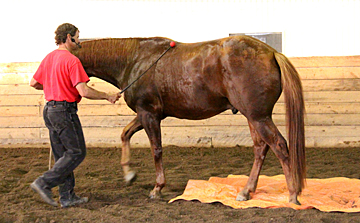
Tapping Otis to help regain relaxation after crossing the tarp
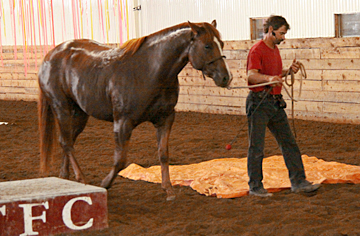
A calm, and more confident Otis.
trainers and clinicians modify techniques to suit their needs, and the needs of their students - both human or equine. This
technique, when combined with shape control and Natural Horsemanship, I have found to be an exceptional
way to lead a horse and facilitate a very healthy partnership.